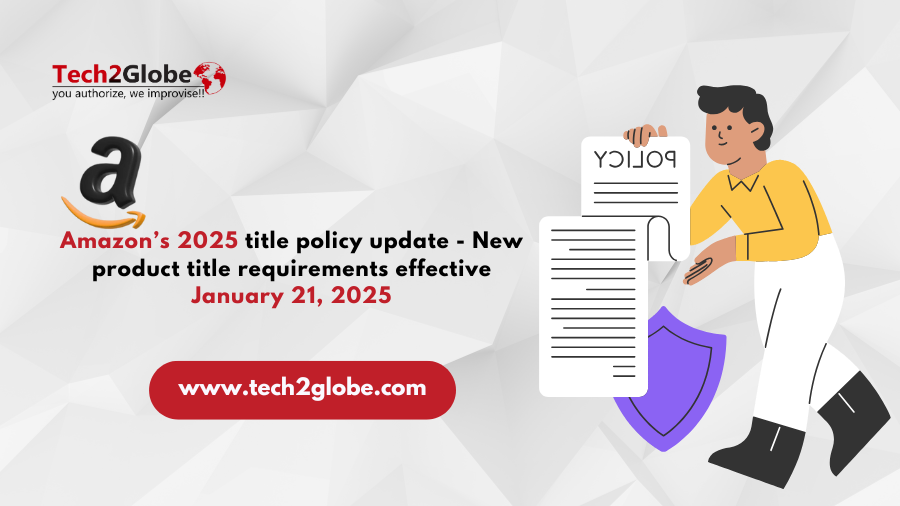Summary: Are you selling on Amazon? Then you need to know about Amazon’s latest product title policy update, now applicable across all Amazon stores globally. This change sets new limits on character length and keyword repetition, ensuring clear, customer-friendly listings.
Amazon titles have always been important to product visibility and customer engagement. With the right image, reviews, and prices, it makes a significant impact on customers when they search for a product, leading to better rankings in Amazon’s SERP (Search Engine Results Page).
However, considering the importance of clear and concise product listings, Amazon’s title policy change suggests that for better customer experience, search accuracy, and compliance, the titles must be short, relevant, and free from excessive keywords. Conversely, titles with lengthy descriptions, repetitive keywords, or unnecessary special characters will not be approved or displayed properly.
Why is Amazon Updating its Title Policy?
The aim of Amazon’s title policy update is to enhance the shopping experience by making product titles more user-friendly and professional. Many shoppers encounter titles with excessive keywords or overly long descriptions, which can be confusing and reduce trust. This makes it important to mention that 90% of best-selling products use at least 50 characters wisely, demonstrating the effectiveness of concise and relevant titles. As a result, this further clarifies why Amazon’s title policy changes are necessary to maintain clarity and consistency.
What Are the Crucial Changes in the New Policy?
Character Length Restrictions
The latest update sets a 200-character cap for most categories, while some apparel items are restricted to 125 characters. Although Amazon has always promoted concise titles, many sellers have relied on longer titles for better indexing. With the new 80-character limit, Amazon is now enforcing stricter guidelines, ensuring product titles remain relevant and easy for customers to read.
Special Characters Are Restricted
Amazon has tightened its rules on special characters in product titles, restricting most symbols except for pipes “|” and dashes “-.” Characters like !, $, ?, and _ are now banned unless they are part of a registered brand name. Some, like ~ and #, are allowed in specific cases, such as product identifiers. Additionally, Amazon strictly prohibits decorative symbols to keep listings clear and professional.
Limits on Keyword Repetitio
Amazon’s updated title policy now restricts the use of the same word to a maximum of twice, except for prepositions, articles, and conjunctions. This change makes it harder for sellers who rely on repeated keywords to optimize their listings. Additionally, during Amazon’s AMA on Jan. 8, it was confirmed that plurals and variations of a word also count as duplicates, requiring sellers to refine their keyword strategies carefully.
Impact of Amazon New Title Rules on Your Listings
Learn how Amazon new product title requirements can affect your listings:
Amazon Will Flag Non-compliant Titles
If your product titles do not meet the new requirements, such as exceeding the 200 character limit, using restricted special characters, or repeating words too many times—Amazon will flag them as non-compliant. This means your listings may not appear as expected in search results until corrected.
14-Day Window for Brand Owners to Update Titles
For flagged titles, brand owners will receive suggested corrections from Amazon through the Review Listing Updates tool. You will have 14 days to accept or modify these suggestions to bring your titles into compliance. If you don’t optimize the title, Amazon will automatically update the titles according to the new guidelines.
Listings Will Remain Active During Compliance Updates
Even if Amazon flags a title for non-compliance, it won’t immediately remove or deactivate your product listing. Instead, it will remain active, allowing you to continue selling while you make necessary updates. However, failure to comply in time may impact your product’s visibility and discoverability in search results.
How to Optimize Amazon Product Titles for 2025
Sellers must go beyond compliance with the new standards in place to guarantee their titles function. As follows:
Add the Appropriate Keywords
Investigate keywords carefully to find terms your clients use. For best effect, start the title with the most crucial keywords. When possible, incorporate synonyms and alternative words to broaden the audience and prevent the title from being excessively complex.
Use Detailed Yet Concise Language
While avoiding needless terms or phrases like “best seller,” include important specifics, such as brand name, product type, size, color, and vital characteristics. Although Amazon accepts 200 characters, community insights point to typically greater outcomes from sticking under 150 characters.
Pay Special Attention to User Intent
Know the intentions, and look for those that your clients seek. Create titles emphasizing durability, comfort, or practicality—benefits or use cases that speak to your readers.
Use Formatting Guidelines
Unless otherwise directed by Amazon, capitalize the initial letter of important terms, use numerals for numbers, and spell out measurement units. Good formatting guarantees compliance and helps consumers to trust you.
Test and Maximize
Test versions of your titles using resources such as Amazon’s “Manage Experiments” capability. Little tweaks like reordering keywords or enhancing readability may have a big effect on CTR and conversion rates.
Harmonize Readability with SEO
Keywords are important, but readability is also crucial. Natural and human-friendly titles especially help develop confidence with customers. Success depends on finding the proper mix between SEO and readability.
Conclusion
So, the new Amazon title policy is here! It’s time to review your listings and make the necessary changes to ensure Amazon doesn’t flag your products and they continue to perform well. If you need further assistance in understanding this new policy, our eCommerce professionals are ready to help. Write to us or give us a call—get a response within 24 hours!
Also Read:
Google Ads in 2025: What to Expect From Paid Search
Google Rolls Out December Spam Update 2024
Top 50 Digital Marketing Interview Questions and Answers for 2025
Frequently Asked Questions (FAQs)
Q.1. What are the rules for Amazon titles?
A.1. Product names are what Amazon needs to meet character restrictions, eliminate promotional language, and cut out special characters. To guarantee compliance and prevent listing limits, titles ought to be clear, relevant, and formatted following category rules.
Q.2. Can I change the title of my Amazon listing?
A.2. You may change your product title in Seller Central by a flat file upload. Upload the file, check for mistakes, and wait 24 hours to guarantee correct reflections of updates after revisions.
Q.3. How long can an Amazon title character be?
A.3. Although Amazon usually only allows 200 characters for product names, some categories could have fewer restrictions. Review category-specific rules to ensure your listings stay current and help prevent compliance problems.
Q.4. Can I include special characters in my product titles after the update?
A.4. Amazon’s revised policy restricts the use of special characters in product names. If your brand name calls for them, look for notifications in Seller Central and change titles to keep compliance.

Sarabjeet Singh is the Vice President of Operations at Tech2Globe and brings over 15 years of experience in various industries, including IoT, education, retail, government, FMCG, hospitality, and e-commerce. His leadership focuses on operational excellence and exceeding customer expectations, implementing contemporary solutions. Sarabjeet’s expertise spans e-commerce consulting, software development, data management, BPO/KPO support services, digital marketing, graphics, and startup consulting. He fosters a collaborative work environment, ensuring Tech2Globe delivers high-quality solutions.










